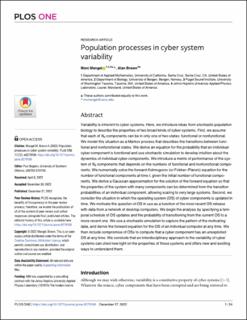| dc.contributor.author | Mangel, Marc | |
| dc.contributor.author | Brown, Alan | |
| dc.date.accessioned | 2023-02-09T12:02:13Z | |
| dc.date.available | 2023-02-09T12:02:13Z | |
| dc.date.created | 2023-01-10T13:18:13Z | |
| dc.date.issued | 2022 | |
| dc.identifier.issn | 1932-6203 | |
| dc.identifier.uri | https://hdl.handle.net/11250/3049670 | |
| dc.description.abstract | Variability is inherent to cyber systems. Here, we introduce ideas from stochastic population biology to describe the properties of two broad kinds of cyber systems. First, we assume that each of N0 components can be in only one of two states: functional or nonfunctional. We model this situation as a Markov process that describes the transitions between functional and nonfunctional states. We derive an equation for the probability that an individual cyber component is functional and use stochastic simulation to develop intuition about the dynamics of individual cyber components. We introduce a metric of performance of the system of N0 components that depends on the numbers of functional and nonfunctional components. We numerically solve the forward Kolmogorov (or Fokker–Planck) equation for the number of functional components at time t, given the initial number of functional components. We derive a Gaussian approximation for the solution of the forward equation so that the properties of the system with many components can be determined from the transition probabilities of an individual component, allowing scaling to very large systems. Second, we consider the situation in which the operating system (OS) of cyber components is updated in time. We motivate the question of OS in use as a function of the most recent OS release with data from a network of desktop computers. We begin the analysis by specifying a temporal schedule of OS updates and the probability of transitioning from the current OS to a more recent one. We use a stochastic simulation to capture the pattern of the motivating data, and derive the forward equation for the OS of an individual computer at any time. We then include compromise of OSs to compute that a cyber component has an unexploited OS at any time. We conclude that an interdisciplinary approach to the variability of cyber systems can shed new light on the properties of those systems and offers new and exciting ways to understand them. | en_US |
| dc.language.iso | eng | en_US |
| dc.publisher | PLOS | en_US |
| dc.rights | Navngivelse 4.0 Internasjonal | * |
| dc.rights.uri | http://creativecommons.org/licenses/by/4.0/deed.no | * |
| dc.title | Population processes in cyber system variability | en_US |
| dc.type | Journal article | en_US |
| dc.type | Peer reviewed | en_US |
| dc.description.version | publishedVersion | en_US |
| dc.rights.holder | Copyright 2022 The Author(s) | en_US |
| dc.source.articlenumber | e0279100 | en_US |
| cristin.ispublished | true | |
| cristin.fulltext | original | |
| cristin.qualitycode | 1 | |
| dc.identifier.doi | 10.1371/journal.pone.0279100 | |
| dc.identifier.cristin | 2104136 | |
| dc.source.journal | PLOS ONE | en_US |
| dc.identifier.citation | PLOS ONE. 2022, 17(12), e0279100. | en_US |
| dc.source.volume | 17 | en_US |
| dc.source.issue | 12 | en_US |

